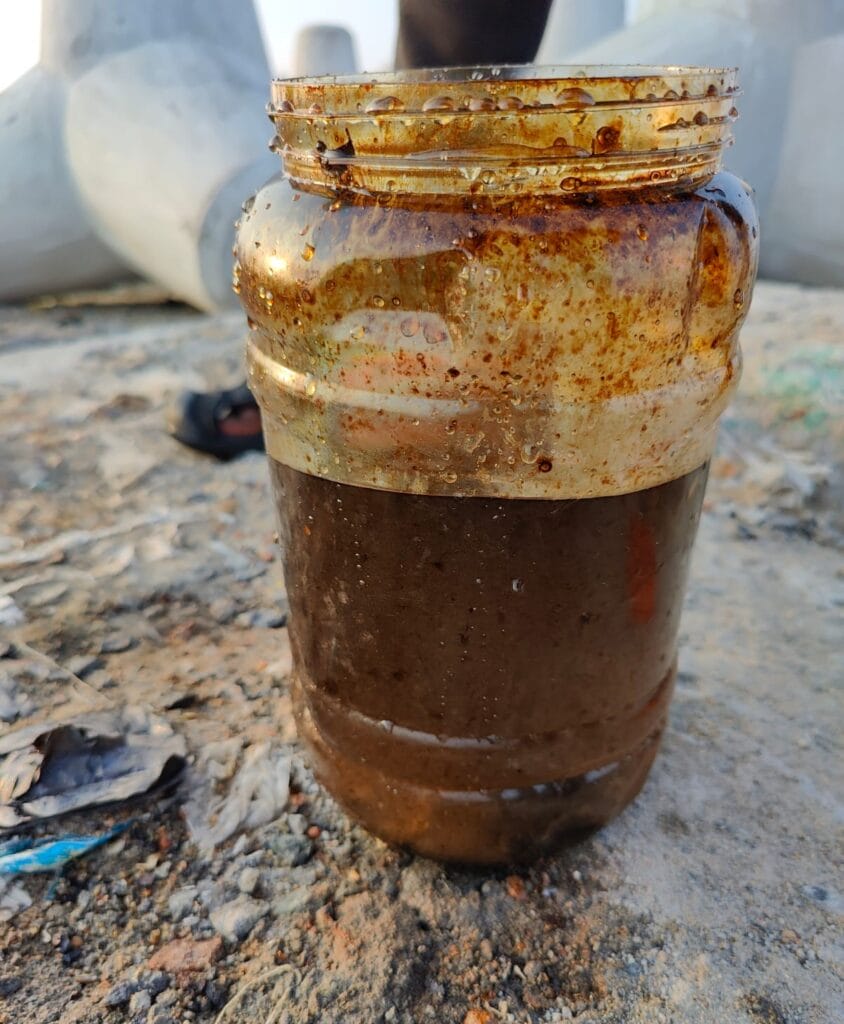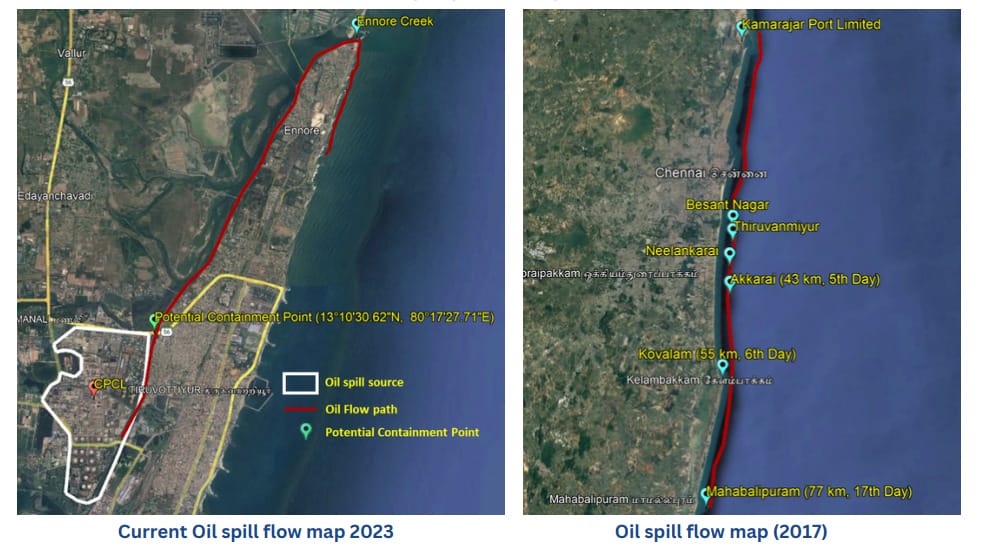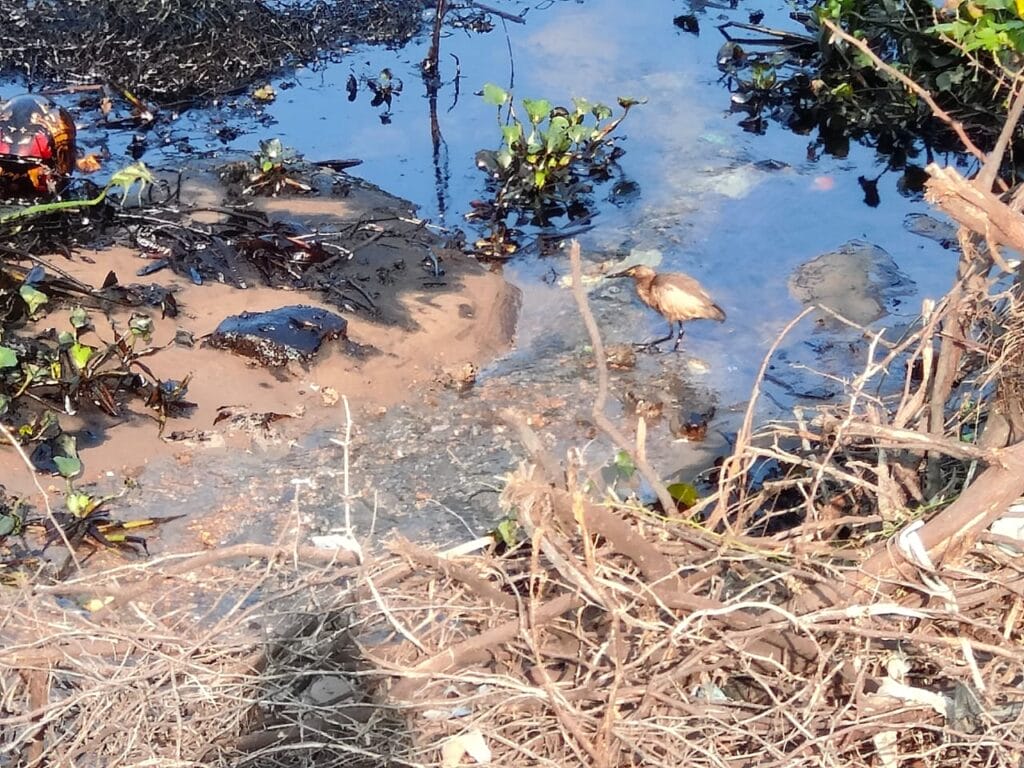As Chennai citizens are slowly trying to get back to normalcy after the destruction from floods following Cyclone Michaung, another disaster is unfolding in North Chennai. A few days ago, locals in the Manali area of the city, which was flooded following heavy rains, reported finding high amount of oil residue in the waters in the region close to the Chennai Petroleum Corporation Limited (CPCL). A viral video has since been circulated that shows volunteers who went to distribute food and essentials to families in Ernavoor, wading through flood waters that was totally contaminated by an oil spill. While local authorities were quick to brush it away as a minor incident, the National Green Tribunal has ordered for a probe into the issue.
Meanwhile, a five-member team of experts and volunteers from Suzhal Arivom, a voluntary environmental education, research and conservation organisation has prepared a Rapid Assessment Report (RAR) based on a field study done on December 9, 2023 from 12.30 pm to 5.30 pm. The report has revealed that the oil spill is spreading rapidly and can cause grave damage to the Ennore Creek and further down the shoreline.
Findings from the field study
The oil spill that has occurred near CPCL in the Manali region has now reached the Kotralai (Kosasthalai) River via Buckingham Canal and is entering into the sea through the Ennore Creek. Our team has done a field study from its potential origin near CPCL (13.1550972, 80.2848757-Google Map coordinates) to the end at Ennore Creek. We feel it has originated here as the inflow of oil sludge along with water is high in volume here.
The oil spill smells like petrol and we observed that it causes eye irritation and difficulty in breathing. Our study found that the oil spill hasn’t stopped at the source and we couldn’t see any effort made by concerned authorities to contain the oil sludge at any place from CPCL to Ennore Creek. We urge the concerned authorities to act swiftly to contain the oil spill on a war footing.
Ennore Creek wetland is a biodiversity hotspot that hosts more than 100 species of flora (including mangroves), 100 species of birds (including migrants, Near Threatened & Schedule I species), fish, molluscs, nereis, turtles and crustaceans among others. It is a fragile ecosystem and highly eco-sensitive. It acts as a source of livelihood for thousands of families in this region who depend on marine resources. This oil spill will have a devastating impact on them.
If this oil spill is not contained at the source or before reaching Ennore Creek, based on its density the oil sludge may gradually reach Besant Nagar, Thiruvanmiyur, Neelangarai, Akkarai, Kovalam, Mahabalipuram and even up to Kalpakkam along with the moving water and impact the entire shore. The study found that traces of the oil have already reached Thiruvottiyur.

Similar oil spill in 2017
Possible Containment Location: https://goo.gl/maps/C1gdk6SMBtAX3C859

Our team has worked on and recorded a similar occurrence of oil spill that happened near Ennore Port in February 2017. During that spill, oil sludge had reached as far as Akkarai in five days from the origin (Ennore Port). The next day it reached Kovalam and consequently Mahabalipuram and Kalpakkam. Now, owing to the still prevalent Northeast monsoon, we expect the oil may travel faster than before guided by air and water currents.
This is the right time for us to learn from history and act promptly to reduce the catastrophe from this happening. Once the oil enters the sea, it cannot dissolve in water. It will be washed along with the marine organisms or plastic waste or debris to the shore and settle on our shores forever. Due to change of currents if the leaked oil sludge moves towards the North, it will impact the biodiversity-rich Pulicat Lake. We need to watch out for the sea movement of oil sludge cautiously with help from local fishermen and take prompt action.
Read more: Can a price tag on the wetlands of Chennai spur restoration efforts?
Ecological Impact of Oil spill on the coast and marine life
Once oil enters the ocean it will have wider negative impact on flora and fauna of our coast affecting near shore fishery and altering estuary food chain resulting in biodiversity and livelihood loss. Seaweeds that grow well during monsoon time in coastal inter-tidal zone which is home to several marine creatures will be destroyed. Mangroves, which are plants with respiratory roots, will also be affected.
Oil cover increases oxygen demand for underwater creatures. Oil destroys the water repellent ability of shore bird’s feathers, thus exposing them to harsh elements. We witnessed several plants, fish, few birds impacted by this oil spill in our short field visit. Without the ability to repel water and insulate from the cold water, birds and mammals will die from hypothermia. Many birds and animals also ingest oil when they try to clean themselves, which can poison them.

The east coast acts as a nesting ground for migrating sea turtles and if the oil spill is not contained now, incoming turtles expected to come from January may decline due to this spill. Juvenile sea turtles could be trapped in oil and mistake it for food. Large fish and shellfish (crustaceans and molluscs) may not be exposed immediately, but can come into contact with oil if it is mixed into the water column. Shellfish can also be exposed in the intertidal zone. When exposed to oil, adult fish may experience reduced growth, enlarged livers, changes in heart and respiration rates, fin erosion, and reproduction impairment. Fish eggs and larvae can be especially sensitive to lethal and sublethal impacts. Even when lethal impacts are not observed, oil can make fish and shellfish unsafe for humans to eat.
Impact on seafood: Scientists have determined that polycyclic aromatic hydrocarbons (PAHs) are the chemicals in oil that are most likely to accumulate in seafood. PAHs also pose the greatest potential health risk to people who eat seafood contaminated by oil. Some PAHs, such as benzo[a]pyrene, may cause cancer. Other PAHs may cause ‘taint’—a disagreeable flavour or odour not typical of the seafood. Bivalve molluscs (mussels, clams, and oysters) are usually immobile and cannot move away from the oil. They have less ability to remove PAHs from their bodies and are more likely to retain PAHs that pose more of a health risk for humans consuming them.
Immediate action required
Read more: Chennai’s environmental issues put the spotlight on TNPCB
Necessary action needs to be taken immediately to ensure that the oil spill is contained at source. The government machinery including Tamil Nadu Pollution Control Board (TNPCB), Indian Oil Corporation (IOC), CPCL and Fisheries department must work in tandem to remove the oil spill and protect the ecosystem and the fishers who depend on the creek for their livelihood. They must contain the further flow of oil sludge at feasible locations and restrict flow into the Bay of Bengal.
In our field visit, we found few points where we could possibly contain oil sludge from entering into Ennore Creek and further to the East coast of India. We suggest the location (13.1750524, 80.2909867 – Refer map) at Buckingham canal where width of the canal is minimal for containing the oil spill. The oil spill appears thick, viscous and is floating on the surface of the flowing water along with other debris. We request government authorities to look at this location and plan on restricting flow of oil sludge using booms and skim it out.
Below are the steps suggested by InnoVoTek for containing oil sludge movement further into the east coast of India:
- Booms (Long, floating, interconnected barriers used to minimise the spread of spilled oil) can be deployed to restrict the oil from flowing and entering the larger water bodies (sea). Booms stay on the water surface and prevent the floating layer of oil to stay while allowing water beneath to flow.
- A filter mechanism like wire mesh should be placed before the boom line at some distance to prevent large floating debris flowing in and damaging the boom.
- Floating debris should be continuously removed which is possible considering the manageable width of the water flow at this location.
- Oil slick thus restrained should be skimmed out mechanically using vacuum pumps or manually and carried off using container lorries.
- Oil collected should later be disposed off appropriately at safe locations. Oil eating bacteria’s can be used for disposal at closed environment. Solutions given by The Energy and Research Institute (TERI) on this will help one understand this better.
- Oil sludge that had entered the sea needed to be assessed and removed manually using tools across the impacted coast for several days.
The Government needs to have a ready-to-go oil filtering mechanism to contain such spills so that the mistakes of 2017 and the current one, are not repeated. There should be constant monitoring and vigilance of the oil-related industries to avoid such disasters.